Learning Electric Guitar can feel like stepping into a world of endless possibilities. The thrill of playing your favorite riffs and solos is now more accessible than ever. Forget the limitations of the past; today’s aspiring guitarists are armed with a vast arsenal of online resources, from interactive lessons to detailed gear reviews and vibrant online communities.
While the personalized guidance of a guitar teacher offers undeniable benefits, mastering the electric guitar on your own is absolutely within reach. All it takes is a spark of passion, a healthy dose of motivation, and a structured approach to keep you progressing.
This comprehensive guide is designed to equip you with the essential tips and tricks you need to confidently embark on your journey of learning electric guitar independently. Let’s dive in and get you rocking!
Getting Started with the Right Gear
The Importance of a Quality Electric Guitar
Embarking on your electric guitar journey with top-of-the-line, vintage instruments might be a dream for the future, but it’s certainly not a necessity for beginners. However, investing in suitable and reliable gear from the outset will significantly smooth your learning curve and make the entire process far more enjoyable.
A guitar that plays comfortably and stays in tune is paramount. It will positively influence your progress in countless ways, making practice sessions more productive and less frustrating. Imagine trying to learn when your guitar constantly goes out of tune or the strings are too high off the fretboard – it’s an uphill battle!
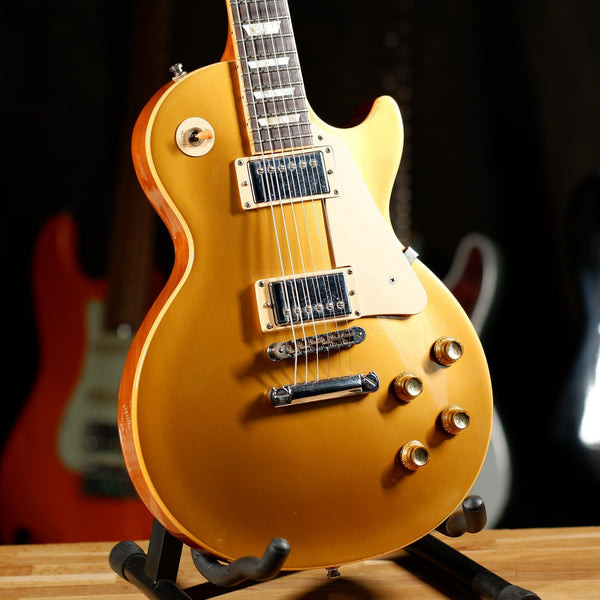 Beginner electric guitars for learning
Beginner electric guitars for learning
While every guitar possesses its unique characteristics, several brands are known for producing beginner-friendly instruments that offer excellent value and reliability. Brands like Fender Squier, Epiphone, and Yamaha Pacifica consistently receive high marks for their quality beginner models. These brands offer guitars that are well-constructed, playable, and won’t break the bank.
It’s crucial to remember the adage: you get what you pay for. While the allure of an ultra-cheap $80 guitar online might be tempting, these instruments often suffer from poor construction, inferior sound quality, and can actually hinder your learning progress. Investing a bit more upfront in a reputable beginner guitar will pay dividends in the long run.
Essential Amplifier and Cable
Alongside a decent guitar, a functional amplifier and a dependable guitar cable are non-negotiable components of your electric guitar setup. Luckily, the market is brimming with affordable and versatile amplifier options, particularly modeling amplifiers.
Modeling amplifiers are a fantastic choice for beginners due to their ability to emulate, through software, the sounds of numerous classic and contemporary amplifiers. This means you can experiment with a wide spectrum of tones, from sparkling cleans to crunchy overdrives and soaring distortions, all within a single, budget-friendly amplifier.
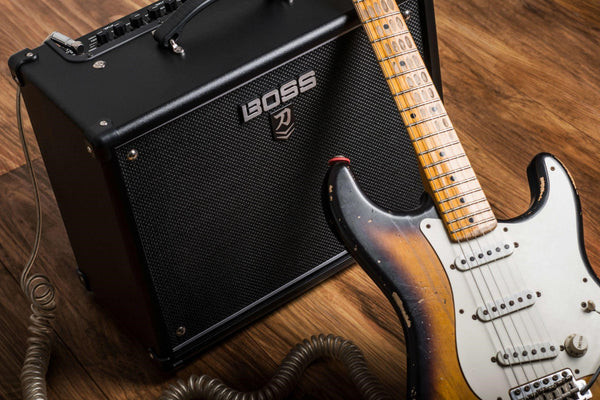 Modeling amps for electric guitar practice
Modeling amps for electric guitar practice
This sonic exploration is incredibly valuable when you are learning electric guitar. It allows you to discover the types of tones that resonate with your musical tastes without the need to invest in multiple expensive amplifiers. As you progress and develop a more refined ear, you can always upgrade to a higher-end amplifier that specializes in the specific sounds you love.
Picks, Straps, and Accessories
To complete your essential gear collection, you’ll need to select appropriate guitar picks and a comfortable guitar strap. Don’t underestimate the impact of these seemingly minor accessories on your playing experience.
Guitar picks are available in a dizzying array of shapes, sizes, and thicknesses. Some are large and triangular, while others are small and teardrop-shaped. Thickness also varies greatly, from extra-thin and flexible to extra-heavy and rigid.
The best approach is to experiment! Consider purchasing a sample pack of assorted guitar picks. This will allow you to try out different styles and discover which pick types feel most comfortable in your hand and produce the tones you prefer.
For playing while standing, a comfortable guitar strap is essential. Look for a strap that is wide enough to distribute the weight of your guitar evenly across your shoulder and made from a material that won’t dig into your skin.
Finally, strap locks are a worthwhile investment, especially as you become more confident and start moving around while playing. Strap locks replace your guitar’s strap buttons and physically secure your strap to the guitar, preventing accidental slips and drops – a small investment that can save your guitar from potential damage.
Understanding Your Electric Guitar Gear
Know Your Instrument
Taking the time to thoroughly understand your new gear is a crucial step in learning electric guitar. Delve into the owner’s manuals for your guitar and amplifier. Familiarize yourself with every knob, switch, and input. This knowledge will empower you to take control of your sound and effectively troubleshoot any issues that might arise down the line.
Pickups and Tone
Electric guitars, while diverse in design and features, share fundamental components. These include the body, neck, frets, strings, pickups, tuning pegs, nut, bridge, and a set of knobs and switches.
Understanding the function of each component is key to unlocking the full potential of your instrument. Pay particular attention to the pickups, knobs, and switches, as these are the primary tools for shaping your guitar’s tone.
For instance, if you own a Stratocaster-style guitar, it will likely be equipped with single-coil pickups, a five-way toggle switch, and a set of volume and tone control knobs.
Single-coil pickups, a standard feature in many Strat-style guitars, are characterized by a single magnet wrapped in copper wire with six pole pieces. This design contributes to their signature bright, clear, and articulate sound, often described as “spanky” or “glassy.”
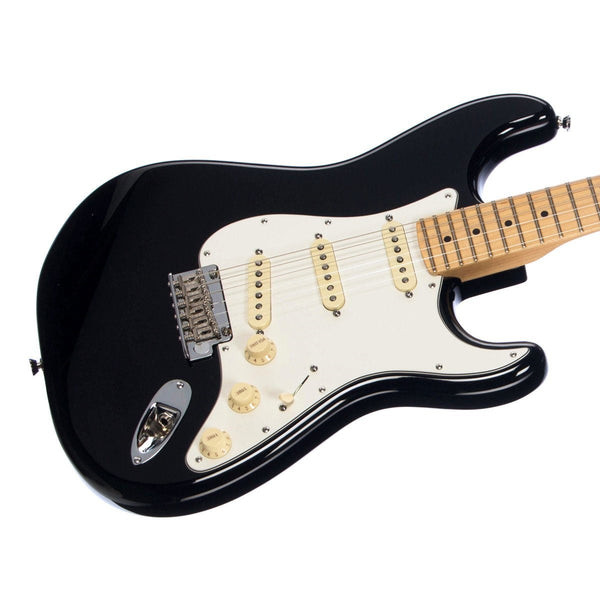 Single coil pickups on a Stratocaster
Single coil pickups on a Stratocaster
In contrast, humbucking pickups utilize a pair of magnets wrapped together in copper wire. This configuration results in a thicker, warmer, and more powerful tone compared to single-coils, often favored in genres like rock and metal.
Toggle Switching
Stratocaster-style guitars typically feature three single-coil pickups, while guitars like Les Pauls or SGs are generally equipped with two humbucking pickups. The toggle switch on your guitar is used to select which pickups are active, thus dramatically altering your tone.
On a Stratocaster with its five-way toggle switch, the positions offer a variety of pickup combinations. With the switch in the leftmost position, you activate the neck pickup, known for its warm and mellow tone. Conversely, the rightmost position engages the bridge pickup, which delivers a brighter and more aggressive sound. The three intermediate positions blend different combinations of pickups, offering a wide sonic palette.
On a two-pickup humbucker guitar, the toggle switch typically has three positions: neck pickup only, both pickups together, and bridge pickup only. Sometimes, these positions are labeled “rhythm” (neck) and “treble” (bridge) on the switch itself. However, don’t be constrained by these labels. Both neck and bridge pickups, and combinations thereof, can be used effectively for both rhythm and lead playing, depending on your desired style and sound.
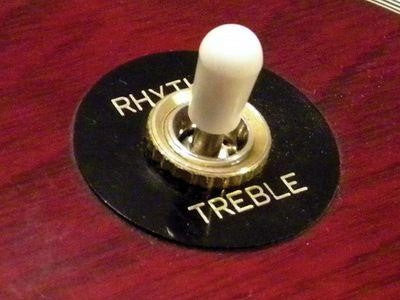 Guitar toggle switch and volume knobs
Guitar toggle switch and volume knobs
The middle position, where both pickups are active, is particularly versatile. By manipulating the individual volume knobs for each pickup, you can blend their signals to create a vast array of tonal textures. For example, you could set the neck pickup volume at 50% and the bridge pickup volume at 100%, or vice versa, to achieve different balances and sonic colors.
Experimenting with these tonal possibilities is a key part of learning electric guitar and will help you unlock a world of creative and inspiring sounds from your instrument.
Tuning and Restringing
Mastering the art of tuning your guitar is a fundamental skill at every stage of your guitar-playing journey. Fortunately, technology has made this process incredibly convenient. Numerous high-quality smartphone apps are available that provide accurate and user-friendly guitar tuners.
For even greater ease and speed, especially in live performance or quick practice sessions, consider a clip-on tuner. These compact devices attach directly to the headstock of your guitar and provide instant and accurate tuning feedback.
For those seeking a more professional and integrated tuning solution, pedal tuners are a popular choice. These stompboxes are incorporated into your signal chain, typically placed at the very beginning.
 Using a tuner pedal for electric guitar
Using a tuner pedal for electric guitar
The signal chain refers to the order in which your guitar signal passes through effects pedals before reaching your amplifier. While there are various schools of thought on pedal order, placing your tuner first is generally considered a safe and effective practice.
In addition to tuning, learning how to change your guitar strings is an indispensable skill. Numerous excellent tutorial videos are readily available online that guide you through the process step-by-step.
While you’re learning to restring, take the opportunity to explore different guitar string gauges and styles. String gauge refers to the thickness of the strings in a set. Lighter gauge strings are generally easier on the fingers, making them a popular choice for beginners. They also facilitate bending and vibrato techniques.
More advanced players, or those seeking a thicker, more resonant tone, often prefer heavier gauge strings. Experimenting with different gauges, much like with guitar picks, will help you discover your personal preferences in terms of feel and sound.
Mastering Guitar Tabs and Chord Charts
The most accessible gateway to learning songs and understanding the electric guitar is through guitar tablature (tabs) and chord charts. You don’t need to be fluent in traditional musical notation to start playing real music on the electric guitar!
Guitar Tablature Explained
Guitar tablature is a simplified notation system specifically designed for guitar. It uses six horizontal lines, representing the six strings of the guitar, instead of the five lines of a traditional music staff.
Tablature is read from bottom to top, meaning the lowest line corresponds to the thickest string – the low E string (6th string). The highest line represents the thinnest string – the high E string (1st string).
Numbers placed on these lines indicate the fret to be played on that particular string. For example, a “1” on the highest line signifies playing the first fret on the high E string.
Similarly, a “5” on the lowest line indicates playing the fifth fret on the low E string.
Tablature provides a visually intuitive way to learn melodies, riffs, and solos without needing to decipher traditional musical notation. It’s a powerful tool for learning electric guitar quickly and effectively.
Understanding Chord Charts
Chord charts are another indispensable resource for self-taught electric guitarists. Many chord charts incorporate chord diagrams, which visually represent how to play specific chords on the guitar.
Chord diagrams might seem a bit daunting at first, but they are quite straightforward to decipher once you understand their layout. Imagine looking down at your guitar fretboard from the bridge towards the headstock. In a chord diagram, the six vertical lines represent the guitar strings, with the low E string on the left and the high E string on the right.
Horizontal lines, typically three to six in number, represent the frets. Dots on the diagram indicate where to place your fingers on the fretboard to form the chord.
Consider this example of a chord diagram for an E major chord in open position:
In this diagram, you see dots on the second fret of the A string, the second fret of the D string, and the first fret of the G string. These dots indicate where you should place your fingers on those frets. Hold down these frets with your fretting hand and strum across the strings with your picking hand to play the E major chord.
The more you practice reading chord charts and diagrams, the more chord shapes you will memorize. This will significantly accelerate your ability to learn songs and expand your chord vocabulary, making learning electric guitar a much smoother process.
Leveraging Online Resources for Guitar Learning
The Internet as a Guitar Learning Tool
We are truly in a golden age for learning electric guitar. The internet has democratized access to information and resources in an unprecedented way. A wealth of learning materials, from video lessons to interactive tablature websites, is readily available at your fingertips.
However, it’s essential to exercise discernment and seek out high-quality resources. Not all information found online is accurate or effective. Be critical of the sources you use and prioritize reputable websites and instructors.
Consider investing in a structured online guitar course and following it diligently. This approach provides a curated learning path, allowing you to track your progress and develop a discerning eye for separating valuable information from less helpful content.
Following a disciplined learning plan is the most reliable path to consistent development as a guitarist.
Choosing a Structured Learning Program
While platforms like YouTube offer a vast library of guitar-related videos, relying solely on random videos can be less effective for structured learning. YouTube channels often lack a cohesive curriculum, leading to a fragmented learning experience.
Avoid getting overwhelmed by the sheer volume of courses and resources available. Instead, choose one structured program or course that resonates with you and commit to following it thoroughly before moving on to other topics.
For example, Guitar Head offers step-by-step programs designed specifically for guitarists. Their course, ‘Guitar Exercises for Beginners,’ provides a dual benefit: it guides you through the fundamentals of learning electric guitar and establishes a strong practice routine to accelerate your progress.
 Online guitar lessons for beginners
Online guitar lessons for beginners
The appealing aspect of such courses is often their efficiency. Many promise significant skill enhancement with relatively short, focused practice sessions, making learning electric guitar more manageable for busy schedules.
Staying Focused and Motivated
Setting Achievable Goals
Self-directed learning demands a certain level of self-motivation and discipline. To maintain focus and track your progress effectively, setting realistic and achievable goals is incredibly beneficial.
Establish both short-term and long-term goals. For example, a short-term goal could be mastering a specific chord progression within a week, while a long-term goal might be learning all five positions of the minor pentatonic scale within five months (dedicating roughly one month to each position).
Setting achievable goals provides direction, prevents feeling overwhelmed, and offers a sense of accomplishment as you reach each milestone, fueling your motivation to continue learning electric guitar.
Creating a Practice Routine
The cornerstone of consistent progress is establishing a solid practice routine and adhering to it. Identify a consistent time slot each day for practice and create a schedule to optimize your practice sessions. Avoid aimless “noodling” for extended periods.
Structure your practice sessions to cover different aspects of guitar playing. Start with warm-up exercises to prepare your hands and muscles. Then, dedicate time to practicing scales and chords to build technical proficiency and fretboard knowledge. Finally, apply your skills by working on learning songs or riffs that you enjoy.
This is just a sample structure; you can tailor your routine to align with your specific goals and musical interests. The key is consistency. Regular, focused practice, even in short bursts, yields far greater results than sporadic, lengthy sessions when learning electric guitar.
The Power of Listening
Active Listening to Music
Listening to music is not passive entertainment; it’s a crucial component of becoming a skilled musician. Immerse yourself in the music of your favorite guitarists and genres. Pay attention to the nuances of their playing, their tone, phrasing, and musicality. You need to develop an ear for what a well-played electric guitar should sound like.
Furthermore, actively seek out new music and artists to keep your inspiration ignited and your musical horizons expanding. Musical stagnation often translates to progress plateaus on the guitar.
Learning from Guitarists
Delve deeper than just listening to recordings. Seek out interviews with guitarists you admire to gain insights into their approaches to music, their practice habits, and their creative processes. Try to understand their musical philosophies and what makes their individual sounds so distinctive.
Attend live performances whenever possible. Experiencing music in a live setting is transformative. Observe how the energy of a performance shifts and evolves with each note, and absorb the atmosphere and dynamics of live music. This immersive experience will enrich your understanding and appreciation of learning electric guitar and music as a whole.
Building a Strong Foundation
Mastering the Basics
Regardless of your preferred musical genre, mastering fundamental guitar skills is non-negotiable. At a minimum, learn the basic open position chords, barre chord shapes, and fundamental major, minor, and pentatonic scale patterns.
These are the foundational building blocks of guitar technique. Developing a strong command of these basics will provide you with versatile skills applicable to virtually any playing situation.
Furthermore, a solid understanding of basic chords and scales is essential for effective communication with other musicians. It provides a common language for discussing music and collaborating with fellow guitarists.
Chords in All Keys and CAGED System
Expanding your chord vocabulary to include chords in all twelve keys is an important step in your musical development. Fortunately, the guitar is uniquely suited to this task, more so than some other instruments like the piano. The CAGED system provides a powerful framework for achieving this.
The CAGED system utilizes five basic open chord shapes (C, A, G, E, D) that can be moved up and down the fretboard to create different chords. For example, the C shape chord, when rooted on the third fret of the A string, becomes a C major chord. By shifting this same C shape up two frets, positioning the root on the fifth fret of the A string, it transforms into a D major chord. This principle of movable shapes applies to all five CAGED shapes.
Scales in All Keys and Movable Patterns
Just as chords have movable shapes, so too do scales on the guitar. Major, minor, and pentatonic scales, among others, have patterns that can be transposed to any key simply by shifting them up or down the fretboard.
For instance, to play the minor pentatonic scale in all twelve keys, you only need to learn one fundamental pattern. By moving this pattern along the fretboard, aligning the root note with the desired key, you can play the minor pentatonic scale in any key.
This movability is a significant advantage of the guitar, simplifying the process of learning scales compared to instruments like the piano, where each scale requires a unique fingering pattern. Understanding and utilizing movable patterns is crucial for efficiently learning electric guitar.
Developing Essential Guitar Techniques
Exploring Guitar Techniques
Identify the signature techniques employed by your favorite guitarists and consciously practice incorporating them into your own playing. The world of guitar techniques is vast and diverse. Some fundamental examples include slides, bends, hammer-ons, pull-offs, legato runs, sweep picking, and tapping.
Each technique adds a unique expressive dimension to your playing. Experiment with these techniques, analyze how your guitar heroes use them, and gradually integrate them into your own style.
Picking Styles
Explore different guitar picking styles to expand your rhythmic and tonal palette. Common techniques include alternate picking (up and down strokes), hybrid picking (using a pick and fingers), and fingerpicking (using fingers only).
Each picking style produces a distinct sound and feel. Experiment with these different approaches to discover which techniques resonate most with you and best suit the musical styles you are exploring.
Learning Songs and Riffs
One of the most effective methods for learning electric guitar, especially for beginners, is to learn a wide repertoire of songs, riffs, licks, and solos. This is how you internalize the “language” of the guitar fretboard.
Like any instrument, the guitar has characteristic playing styles and idioms. It’s crucial to absorb these guitar-specific mannerisms early on in your learning process. By learning songs and analyzing the playing of established guitarists, you’ll naturally absorb these nuances and develop a more authentic and idiomatic guitar style.
Once you have a solid foundation in these fundamental guitar “phrases” and techniques, you can then build upon them and begin to develop your own unique and personal style.
Utilizing a Metronome for Rhythm
The Metronome as a Practice Tool
A metronome is an invaluable tool for any musician, and especially beneficial when learning electric guitar. It’s a device that produces a steady, consistent beat, helping you develop impeccable timing and rhythm.
Numerous excellent metronome apps are available for free download on smartphones, making this essential practice tool readily accessible.
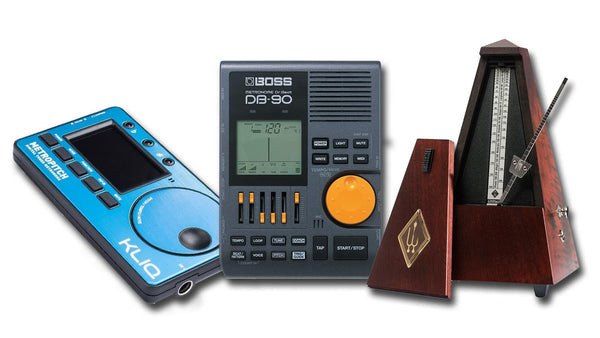 Practicing guitar with a metronome
Practicing guitar with a metronome
Metronome Practice Ideas
The most basic way to use a metronome is to set it to a tempo and play along with all four beats in a measure. However, you can creatively alter your practice to challenge yourself further.
Try setting the metronome to click on only one beat per measure (e.g., beat one) or focus on playing rhythms that fall on the off-beats (the “and” counts between the main beats).
Think of metronome practice like physical exercise for your rhythmic sense. The more consistently you practice with a metronome, the stronger and more ingrained your internal sense of time and rhythm will become. This improved timing will significantly enhance your overall guitar playing.
Self-Assessment Through Recording
Recording Your Practice Sessions
Utilize the voice memo app on your smartphone or any recording device to record your guitar practice sessions regularly. This practice of self-recording and critical listening is a powerful tool for accelerating your progress when learning electric guitar.
After recording yourself, listen back attentively and objectively. Analyze your playing as if you were listening to another guitarist. Identify areas that need improvement, such as timing inaccuracies, sloppy technique, or inconsistencies in tone. Also, acknowledge and appreciate the aspects of your playing that you are pleased with.
Reflection is Key
Listening back to your own playing provides invaluable insights into your strengths and weaknesses. It’s a crucial step in self-reflection and self-correction. By being honest and realistic with yourself during this critical listening process, you will identify areas for focused improvement and achieve your guitar goals more efficiently.
Embracing Music Theory
Music Theory Demystified
Music theory, often perceived as intimidating or overly academic, is simply a framework of concepts, tools, and a shared language that musicians use to describe and understand the patterns and tendencies in music. Don’t be afraid to delve into music theory. It is a powerful ally in your journey of learning electric guitar.
Music Theory is Your Friend
A common misconception among self-taught musicians is that learning music theory will stifle their creativity or make their playing sound rigid and formulaic. The reality is quite the opposite.
Avoiding music theory is akin to limiting yourself to a small vocabulary when learning a spoken language. By neglecting music theory, you are effectively cutting yourself off from a vast universe of musical understanding and expressive possibilities that would otherwise be accessible to you. Music theory, when understood and applied creatively, can actually liberate your musical expression and enhance your improvisational skills.
Finding Your Guitar Community
The Importance of Community
Perhaps the most overlooked yet profoundly important aspect of learning electric guitar, especially when self-teaching, is finding and engaging with a community of fellow guitarists and musicians.
Surrounding yourself with like-minded individuals who share your passion for music provides invaluable support, inspiration, and learning opportunities. The best way to stay motivated, discover new musical ideas, and deepen your understanding of music is through interaction and discussion with other musicians.
 Guitar community learning together
Guitar community learning together
Whether your community is primarily online, through forums and social media groups, or predominantly in-person, through local jam sessions and music circles, having a network of guitarists to connect with will accelerate your development and keep you focused and engaged. Who knows, you might even find bandmates and start your musical journey together!
Considering Online Guitar Courses
Structured Online Learning
In today’s digital age, anyone with internet access can embark on learning electric guitar. The abundance of online resources is both a blessing and a potential curse. While YouTube offers a vast sea of free content, it’s not always the most effective platform for structured learning.
YouTube often lacks the systematic curriculum and personalized guidance necessary for optimal progress. It can be easy to get lost in a maze of unrelated videos, jumping from one topic to another without a clear learning path.
For a more efficient and rewarding learning electric guitar experience, consider enrolling in a reputable online guitar course. A well-structured course provides a logical progression, step-by-step instruction, and often includes feedback and support, leading to faster progress and a more enjoyable learning journey.
For instance, Guitar Head’s “Guitar Exercises for Beginners” course offers a comprehensive program with over 100 exercises designed to take you from a beginner to a more proficient player. Many such courses also emphasize efficient practice techniques, like Guitar Head’s claim of “10X your guitar skills in 10 minutes a day,” making learning electric guitar accessible even with limited time. Check out the course here.
Conclusion
Learning electric guitar is an incredibly rewarding journey, and with the wealth of resources available today, it’s more accessible than ever before. By equipping yourself with the right gear, understanding your instrument, utilizing online resources effectively, and cultivating consistent practice habits, you can confidently navigate the path of self-instruction.
Remember to set achievable goals, embrace the power of listening, build a strong foundation in the basics, and connect with a community of fellow musicians. Don’t be intimidated by challenges; view them as opportunities for growth.
Start your learning electric guitar adventure today, and most importantly, enjoy the process of creating music and expressing yourself through this incredible instrument! Explore guitarplayers.net for more resources and inspiration to fuel your musical journey.

